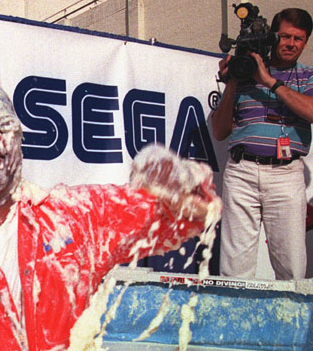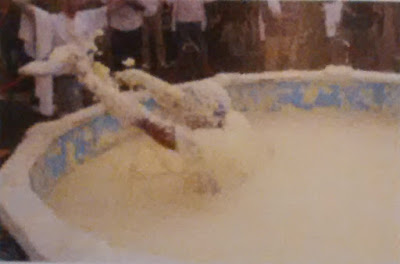Long time readers of the Junkyard will no doubt be aware of my penchant for the obscure, the esoteric and the forgotten. Naturally, due to my obsession with the Dreamcast, there's something of a Venn diagram crossover where all of these ingredients are thrown together - obscure, esoteric, largely forgotten stuff relating to the Dreamcast is my bread and butter. But never Marmite. Yuck.
Take for example, my quest to unearth the actual court documents relating the the City of Milwaukee's failed attempt to probhibit the US release of Jet Set/Grind Radio owing to the conurbation's battle with unauthorised graffitti. Or the (currently dormant) attempt to discover the identity of the female voice artist responsible for the "This is a Dreamcast disc..." warning that PAL Dreamcast owners are undoubtedly familiar with. And who can forget the publication of the Sega internal email that heralded the end of the Dreamcast, but recreated in the style of House of Leaves? There was something about the barber from the European Dreamcast TV adverts too. Another one of these wild flights of fancy was my attempt to document the lesser known Sega Spud Dive PR events - something I was even able to quiz none other than former Sega of America President Peter Moore on when he appeared on episode 100 of our podcast DreamPod.
 |
| 1998 Spud Dive winner Daniel Aguilar receiving his prize from Peter Moore |
I'm not about to retread old ground here though. No, as stated, we've covered the Spud Dive previously. What I'm specifically focusing on now is the fact that while the Sega Spud Dive events were reasonably well documented with photographs in magazines of the time; have seen first person blogs on the event posted online; and were also recapped on some PR focussed websites of the era, there doesn't seem to be any video of either Spud Dive event anywhere online.
 |
| Proof that Mark Wahlberg took video of a Spud Dive |
To clarify, there were two seperate Spud Dives - one held in 1998 to mark the Japanese launch of the Dreamcast, where the prize was a US launch day console and all of the launch games (later presented by Peter Moore); while the second event was held around Thanksgiving of 2000 to raise awareness of the console during the height of PlayStation 2 launch window fever. The second event also featured two actors dressed as Presidential candidates Al Gore and George W. Bush, to give a 'newsy' angle, apparently.
 |
| Source: Retrovolve |
That no video exists of either Spud Dive (or indeed a prior similar event held in 1997 to mark the launch of Sonic R) is particularly puzzling, especially because this article from organiser Provoke Media's website claims that several TV crews were in attendence at the 2000 re-run, and the event was featured in a news segment by the Craig Kilborn Show - a US TV show which was hugely popular at the time.
"All coverage of “The Sega Spud Dive” aired the week of Thanksgiving, the busiest shopping time of the year. More than 82 broadcast results appeared, including the Craig Kilborn Show and the ABC, CBS and Fox affiliates in Los Angeles, Philadelphia, Washington DC, Miami, Atlanta, San Diego, Phoenix, Chicago, Dallas, Boston, Indianapolis, Denver, Cincinnati, Oklahoma City, Milwaukee and many others.
"Los Angeles Daily News sent a photographer and ran a photo with a large caption featuring Sega Spud Dive. 95% of the results mentioned both Sega and Dreamcast. Dreamcast sales went up 82% during Thanksgiving weekend, from previous weeks."
- Paul Holmes, Provoke Media
I have searched high and low for some footage from either Sega Spud Dive event, mainly because I want to witness the absurdity of people swimming through cold mashed potatoes in an attempt to win a Dreamcast/Dreamcast related goodies - but to date I have found zero evidence that actual video of the procedings still exists. I've searched for local news channels that focus on the Los Angeles area and also episodes of the Craig Kilborn Show from around the time period, but even these appear to be lost media in themselves. The article linked above also states that:
"After the event, B-roll was hand-delivered to stations that did not send a camera crew and submitted the photo to the Associated Press, Reuters, Entertainment Wire and LA News Wire, which was distributed via satellite and hand-delivered to local network affiliates to increase national exposure."
Where is this B-roll? Where are these news items that were distributed via satellite? Associated Press, Reuters and Entertainment Wire aren't exactly small outlets or organisations, so why can't I find a single trace of any of this online? There's even a camera operator in the background of the image at the top of this page! I realise that 1998 and 2000 were different times, and people didn't walk around with 4K video cameras in their pockets; but there were news camera crews in attendance...where is the video? I clearly have more questions that answers when it comes to video footage or TV news reports of hapless members of the public swimming through mashed potatoes to win a Dreamcast.
To this end, I'd like to know if anyone out there reading this has any more first hand memories of either of the Sega Spud Dives? Did you take part? Do you have video or do you recall seeing video on TV? Hell, are you Daniel Aguilar - the guy who won the original Dreamcast and took delivery from Peter Moore himself? Or are you Levi Buchanan who won the second Spud Dive competition? I know this is a massive long shot and I know that this obsession of mine is ultimatley pointless, but for some reason this bizarre publicity stunt absolutley fascinates me; and it is the relative lack of documentation, outside of a few magazine articles and online snippets (look here and here, and also from the 8:55 mark during the Video Game History Foundation's Dreamcast launch podcast episode) that makes it all the more alluring. Alas, approximately zero videos.
Anyway, that's all I really have to say on the Sega Spud Dive for now (promise!). Maybe video does exist, but I'm either looking in the wrong places or simply using the wrong search terms. Either way, I'm hoping someone will be able to point me in the direction of some video taken of either event, but for now I'm inclined to file Sega Spud Dive video footage under 'lost media.'















































